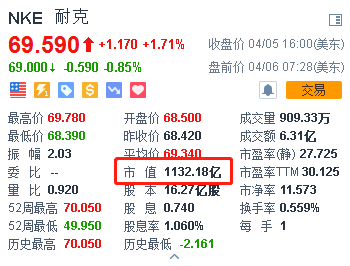
Go ahead, don't stop.
Cowards never leave, the weak die on the way, and only we move on without stopping.
Just like Phil, the founder who is obsessed with running. Two of Phil Knight's favorite words, Nike Inc, he founded, never stopped moving forward: from 1962 to 2018, from the first $25 order to hundreds of billions of dollars of listed companies.
Today, Nike Inc is not only the number one sports brand in the world, but also extends his influence beyond sports, including clothing, fashion, culture and so on.
At present, Nike Inc has a market capitalization of more than $113 billion (about 713.6 billion yuan).

Source: Futu Securities (as of April 6)
In terms of market capitalization, Nike Inc is equivalent to 8.5Anta (about 84.5 billion yuan), 45 Li Ning Co. Ltd., 89 Xtep and 173,361 degrees, which is the king of sports brands.
Count the money until you are soft, and earn 66 million a day.
In the past year (February 2017-February 2018), Nike Inc had revenue of about $35.3 billion (about 222 billion yuan) and adjusted net profit of about $3.82 billion (about 24.1 billion yuan), equivalent to a daily net income of 66 million yuan.

Anta, Li Ning Co. Ltd. and other four listed companies made a total profit of only 4.46 billion yuan last year, less than 1/5 of Nike Inc's.
On March 23, Nike Inc announced Q3 revenue of US $9 billion, an increase of 6.5% over the same period last year, and expected high single-digit revenue growth for Q4.
A 113 billion-dollar family history of getting rich
The market capitalization has increased by 290 times in 1998.
Nike Inc, who now has a market capitalization of hundreds of billions of dollars, was founded with a dramatic intention.
In 1962, in the era of extremely underdeveloped transportation, Phil, the founder who loved running. After graduating from business school, Knight went on a crazy global trip: Hawaii, Tokyo, Hong Kong, Mumbai, Saigon, Cairo, Athens, Jordan, Jerusalem, Rome, Paris, Berlin.
While in Tokyo, Knight, who was a good runner at school, found that the quality of Japanese sneakers was much higher than that of the United States, so he came up with the idea of selling Japanese shoes to the United States, so he got the first order for just $25.
The name of Nike Inc (Nike) also came from Knight during his trip. When he was traveling to Athens, he saw the goddess Athena, the messenger of victory, in the temple of Athena (Temple of Athena Nike), so the company was named "Nike". Coincidentally, Nike also sounds similar to founder Knight.
After 57 years of development, Nike Inc's products sell well in more than 120 countries around the world, accounting for nearly 50% of the market share of middle and high-end sportswear (2017 data).
18 years after its establishment, Nike Inc landed on the New York Stock Exchange on December 2, 1980 (Apple Inc happened to be listed on December 12, 1980, 10 days later). According to founder Knight's description in the book Shoe Dog, he held 46% of the shares at the beginning of the listing. Worth $178 million, Nike Inc was valued at $386 million at that time. Based on the current market capitalization of $113.2 billion, the market capitalization increased 292 times in 38 years, compared with the same period. The Dow is only up about 26 times.
Nike Inc's stock price chart since 1980:

Source: Bloomberg
2. Shoemaker spirit, focusing on shoes for 57 years
In the eight years of Nike Inc's start-up period, the brand Nike Inc did not exist at all. The name of the company is "Blue Ribbon Sports Company". It has only one business, that is, acting for the sale of Japanese shoes in the United States. Interestingly, the Japanese company called Ishizuka, after decades of development, not only did not close down, but also lived very well, but certainly not on the scale of Nike Inc.
However, with the rapid development of Blue Ribbon Company, caused the concern of Ishizuka, Ishizuka proposed to buy a 51% stake in Blue Ribbon, which Knight flatly refused, and then founded Nike Inc in 1972, which made a lot of improvements to running shoes. This is the predecessor of Nike Inc.
From acting for Japanese shoes in 1962, to producing their own shoes, and then to listing in 1980, Nike Inc developed rapidly, surpassing Adidas for the first time in North America in 1980, reaching more than 50 per cent.
At present, Nike Inc's sub-brands include Nike Inc, Jordan, Converse, Hurley (NIKE, Jordan, Converse, Hurley), etc., and the main revenue contribution is Nike Inc brand. For reasons we all know, at present, most of Nike Inc's products are produced in developing countries such as China, Vietnam and Indonesia.
In terms of revenue regional classification, it is mainly divided into North America, Europe, Asia-Pacific region and Latin America, Chinese mainland and other markets, of which North America is the main force, contributing US $15.52 billion in revenue in 2017, accounting for 44% of the total revenue, with a three-year compound growth rate of 7.35%.
The Chinese mainland market, with revenue of US $4.24 billion, is the fourth largest market, but has a three-year compound growth rate of 17.65%.
In terms of product classification, sneakers are Nike Inc's main products, with revenue of US $21.08 billion in 2017, accounting for more than 61% of total revenue, with a three-year compound growth rate of 9.16%, sportswear accounting for more than 28%, and a three-year compound growth rate of 5.99%.

Source: Bloomberg
Is Nike Inc still worth having? Just do it
Fu Tu Information will briefly discuss the future growth of Nike Inc from the following angles.
1. In 2020, Jianzhi had sales revenue of US $50 billion.
In 2015, Nike Inc launched the "five-year Plan"-with revenue of US $50 billion by 2020. In 2015, Nike Inc's revenue was $30.6 billion, which means revenue will grow by 63% in five years.
In the past fiscal year, Nike Inc's income was about 35.3 billion US dollars, that is to say, Nike Inc will achieve 42% growth in the next two years. Such revenue growth can ensure growth in the next few years.
2. Power points: Chinese market, e-commerce, and "women's business"
In order to achieve his 2020 revenue target of US $50 billion, Nike Inc must focus on the Chinese market, e-commerce, and "women's business".
First, let's take a look at the Chinese market. As mentioned earlier, China is Nike Inc's fourth largest market, and its growth rate is also very fast. China is currently in the process of upgrading consumption, and there are great opportunities, and the management has also said that it will increase its investment in the Chinese market.
At present, Nike Inc's North American market is not very optimistic, showing that North American revenue fell 6 per cent in the most recent fiscal quarter (although management expects Q4 to stop falling and return to growth in the first half of the next fiscal year), while China has the fastest growth rate of 24 per cent.
Looking at the e-commerce business, Nike Inc launched an e-commerce plan in 2015, with the goal of increasing online sales from $1 billion to $7 billion within five years.
Finally, "do a woman's business".
Around 1985, women began to attach importance to fitness and sports in the United States, but Nike Inc has always been the main male consumer, so Nike Inc missed a whole wave of fashion, while its competitor Reebok overtook Nike Inc to become the largest sports brand in the United States in only two or three years.
Nike Inc has already suffered a loss in front of women, and this time he should not be so stupid. In 2015, Nike Inc said that in the next five years, the income of women will be nearly doubled from $5.7 billion to $11 billion.
3. Strive for hegemony with Adidas, Under Armour, etc.
In China, Anta, Li Ning Co. Ltd., Xtep, 361o and so on continue to fight, while Nike Inc and competitors also continue to fight. Here, it mainly consists ofAdidas(Adidas, the second largest sports brand in the world) and Under Armour (the second largest sports brand in the United States) are examples.
Let's take a look.Anderma.(UA), two years ago, the market capitalization of Anderma was as high as US $20 billion, but now its sales and net profit have fallen seriously. The stock price has fallen by 77% in two years, and the current market capitalization is only US $6.5 billion. Such a miserable Anderma naturally does not pose a threat to Nike Inc.
Let's take a look at the number one rival Adidas, which currently has a market capitalization of about 50 billion US dollars, which is half that of Nike Inc. Its strategy is similar to Nike Inc's, positioning is global sales, high-end strategy. Judging from the trend of the stock price, Adidas is also advancing by leaps and bounds. It has risen nearly nine times since the financial crisis (Nike Inc is about 12 times).
However, Nike Inc is still the absolute leader in this market, with Nike Inc's global market share of nearly 50 per cent based on 2017 revenue, compared with 16.5 per cent for Adidas, not to mention 3 per cent of Anderma.

With nearly half of the market share and deeply rooted products, Nike Inc will probably dominate the global sports brand in the next N years.
Risk factors: unable to catch the trend
Over the years, Nike Inc's market capitalization has been three or four times that of second-placed Adidas. Nike Inc's market capitalization reached 110 billion US dollars at the end of 2015. Although revenue and profits are still growing, he has lagged behind in a fashion trend-"athleisure", or "sports fashion", that is, the combination of sports and leisure. As a result of the sports + leisure trend, sportswear can be applied to more consumption scenes, thus greatly increasing the market size of sportswear, which is estimated by the New York Times to be as high as 100 billion US dollars. Nike Inc currently has an annual revenue of just over $30 billion.
Rival Adidas has seized on this trend, with its share price nearly tripling over the same period, with a market capitalization of 1/2 of Nike Inc (Nike Inc in red and green and Adidas in pink):

Source: Futu Securities
Prior to this, around 1985, Nike Inc also missed the trend of women's fitness, causing the stock price to fall for two or three years in a row and was overtaken by Reebok.
However, Nike Inc's labor pains seem to have passed, with the disclosure of the financial report, the stock price has recently begun to "dragon rise", a new high.
Is Nike Inc worth having in the future? Is it just do it or just leave it? (by Phil Newell / Huang Jinlin)
